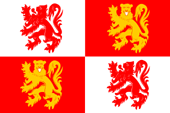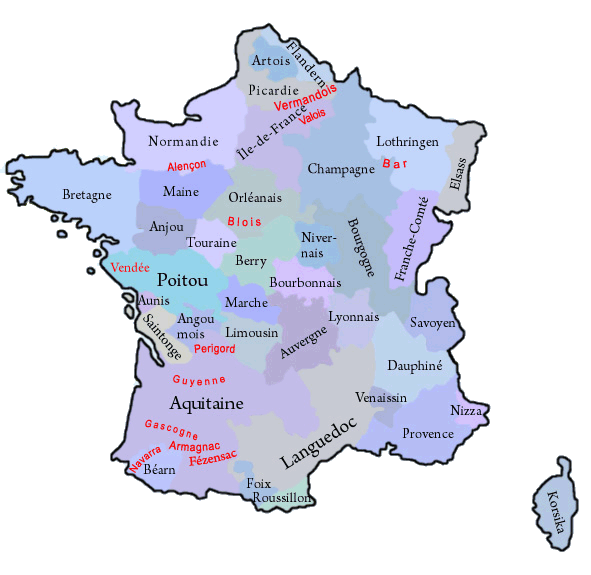mobile View, to the German Version tap the flag


- historical region in France
- former county and province
• Flag
• Meaning/Origin of the Flag
• Coat of Arms
• Meaning/Origin of the Coat of Arms
• Map of the historical Regions in France
• Explanations about the Regions
• History
• Origin of the Country's Name

Flag of Armagnac,
Source, by:
Wikipedia (Fr)




The flag of Armagnac is a scutcheon-flag, Its design is the image of that coat of arms, which has been used in the 14th/15th century.
Source:
Volker Preuß


1140–1215, Armagnac,
Coat of arms of Armagnac – Blason du Armagnac,
Source, by:
Wikipedia (FR)

1215–1304, Lomagne,
Coat of arms of Armagnac – Blason du Armagnac,
Source, by:
Wikipedia (FR)

1304–1497, Lomagne (Grafen/ Counts/ Comtés de Armagnac, Fézensac, Rodez),
Coat of arms of Armagnac – Blason du Armagnac,
Source, by:
Wikipedia (FR)

1391–1497, Armagnac-Pardiac (Lomagne; Grafen/ Counts/ Comtés de Pardiac, Castres, La Marche),
Coat of arms of the House of Armagnac-Pardiac – Blason de Maison du Armagnac-Pardiac,
Source, by:
Wikipedia (FR)

1497–1525, Alençon,
Coat of arms of the House of Alençon – Blason de Maison du Alençon,
Source, by:
Wikipedia (DE)

1525–1607, de Bourbon,
Coat of arms of the House of Bourbon – Blason de Maison du Bourbon,
Source, by:
Wikipedia (DE)

The coat of arms, today known as the coat of arms of Armagnac, goes back to the 14th century. The crest is squared - four times divided - and the first and third field showed a red lion on silver, and the second and fourth field a golden, herelooking lion on red. It came into this form, when the Counts of Armagnac in 1304 acquired the County of Rodez, and their previous emblem, which showed a red lion on a silver, added by the heraldry of Rodez. As in 1391 the County of Pardiac was acquired, was added a blue collar tournament in the head of the shield. In 1497 Armagnac was inherited after the extinction of the House of Lomagne to the House of Alençon. For the line of Valois-Alençon, which began in 1297, when Charles II., son of Charles of Valois, was born, were fixed eight white balls on the red border as the special heraldic feature. The progenitor of the line of Valois, Prince Charles (1270–1325, son of King Philipp III.), Count of Valois, Anjou and Maine, took over the coat of arms from Prince John Tristan (1250–1270, Count of Valois, son of King Ludwig IX.). He surrounded the lily arms of the Capetians with a wide red border. In 1526 the county came to the Capetian House of Bourbon. The respective heraldry showed the blue, with golden lilies topped shield of the Capetians, which was covered with a red oblique-right bar. The coat of arms of the Capetians showed three golden lilies on blue, but originally was the coat of arms sprinkled with lilies. From 1365 (by others sources 1376), the number of lilies was reduced to three. The lily-symbol is very old, already the Germanic tribe of the Franks has used it.
Source:
Heraldique Europeenne,
Wikipedia (FR),
Wikipedia (DE),
Volker Preuß

The historical, French Regions:

in black: governorate and province in 1776,
in red: former county, province oder governorate
Map: Volker Preuß

The until the French Revolution existing provinces (or governorates) have been historically grown structures, which had their roots oftenly in former fiefdoms of the French crown, historic counties and duchies. They oftenly existed for hundreds of years and had preserved regionality (e.g. cultural particularities and regional languages). On the occasion of the French Revolution such phenomena were of course not desirable, and as part of their bloody and violent egalitarianism any regional references were eliminated. Shortly after the French Revolution the provinces were dissolved and France became divided into many départements, which should have approximately the same size and the same status. The départements were named after rivers or mountains, to use never and in no circumstances the name of an old province. However, there was no success in cutting the connections of the people of France to their respective regions, so that administrative regions were re-created in 1960, to have a better control in regional administrative processes. In this way became départements, which were placed in a historical province, administratively grouped to an oftenly historically named region. The resulted structures coincide only approximately with the boundaries of the old provinces. In the strictly centralist France any regionality is avoided, so that even the official flags of these regions mostly look like flags of companies, unloving, unhistorical, technocratic and modernistic, and these flags should not be a subject of any lexical considerations here. Only in a few of that regions, exist official flags which remember the historical models. But, even the existence of these today's regions is douptful, because in 2014 was passed a territorial reform valid from the year 2016, that reduces the number of the existing regions by merging to nearly the half. However, there exist unofficial flags in nearly all of these regions, which should remember the old provinces and the old heraldry.
Wikipedia Link to the regions of France:
click or tap here
FOTW Link to the regions of France:
click or tap here
Source: Flags of the World,
Wikipedia (D),
Volker Preuß

antiquity · colonization by Iberian and Celtic tribes, the largest of them are the Volcae
52 B.C. · Roman conquest, forming the province of Aquitania
in the west of Gaul
418 A.D. · the Visigoths be settled as federates, Aquitaine
belongs to their sphere of influence
5th century A.D. · conquest of Gaul by the Franks (under
King Clovis) to 507 conquest of Aquitaine, expansion of the empire to the
Atlantic Ocean, the Pyrenees and the Alps
6th century · the Basques (Vascons) expand their influence
in the northern Foothills of the Pyrenees and immigrate, they establish
their Duchy of Vasconia (" Gascogne ") in southern Aquitaine
581 · Frankish dukes rule over the Duchy of Gascony
660 · Gascony is incorporated into the Duchy of Aquitaine
771 · Charlemagne takes over Aquitaine and transmits it
later as a kingdom to his youngest son Louis the Pious, Charlemagne
estblishes the County of Fézensac to counter the repeated revolts of the
Basques against the rule of the Carolingians, the first mentioned
Carolingian count is Leuthard of Paris (House of Matfriede)
819 · King Pepin I. of Aquitaine appoints Aznar Sanche to
the Count of Gascony
836 · the County of Fézensac is owned again by the Basques,
it belongs to the Basque Gascony and develops into its central part
848 · Count Sanche Mitarrat calls himself a Duke
880 · by the division of the Frankish Empire (Treaties of
Verdun and Ribbemont) arises the West Frankish Kingdom (later
France), the East Frankish Kingdom (later German
Empire), the Kingdom of Italy, the Kingdom of Upper Burgundy (under
Rudolf the Welf) and the Kingdom of Lower Burgundy persists
920 · death of Garcia Sanchez le Tors, the heritage (the
duchy of Gascony) is divided among his three sons, the majority of Gascony
comes to Sancho III., the Counties of Astarac and Fézensac come to the other
brothers – after the death of William Garcia (960), Count of Fézensac, the county
is divided among the sons, the elder son Othon receives the county Fézensac,
his younger brother Bernard le Louche receives the by the division newly
created County of Armagnac
950 · Aquitaine includes now the counties of
Gascony, Armagnac, Fézensac,
Périgord, Poitou, Angoulême and La Marche
1140 · Count Geraud III. of Armagnac unites his county with
the County of Fézensac because he had remained without a male heir
1182 · death of the last count of Armagnac and Fézensac,
the first house of the Counts of Armagnac extincts in this way, the legacy
goes to the Bernard I. (House of Lomagne) which goes back of Mascarose on
Armagnac, a daughter of Geraud III.
1224 · King Louis VIII. of France, son of Philip Augustus,
conquers Aquitaine, except Gascony the last possession of the Plantagenets
in France, Poitou and Saintonge come
directly to the crown, La Marche,
Périgord, Angoulême and Auvergne
become fiefs
1259 · Treaty of Paris (Abbeville), King Henry III. of England recognizes the loss of Aquitaine, and receives
in this way the Saintonge, which is united with
Gascony
to the Duchy of Guyenne, as fief
1304 · the Counts of Armagnac and Fézensac purchase the
County of Rodez
1328 · death of King Charles IV. (the Fair), extinction of
the direct Capetian line, according to Salic Law Count Philip of Valois (Son
of Prince Charles of Valois, first cousin of King Charles IV.) came on the
French throne (as King Philip VI .), the English king Edward III. lays claim
to the throne as a maternal nephew of Charles IV., reason for the "Hundred
Years War" (Anglo-French War, 1338–1453), out of the House of Valois came
all kings of France from 1328 to 1589
1402 · death of Jean II., Count of Armagnac and Fézensac
and Count of Pardiac, his cousin Bernard VII. of Armagnac takes possession
of the county
1453 · Battle of Castillon, the end of the Hundred Years
War, the Kings of England have to cede all their possessions in France, in
this way the Guyenne comes finally to France, the country is
connected to the royal domain, later establish of the governorate (province)
of Aquitaine, to which the Guyenne belongs as a province
1473 · death of Count Jean V. after fights against King
Louis XI. of France
1497 · extinction of the second house of Armagnac (House
Lomagne), the county comes to Charles IV. of Alençon
1526 · Marguerite d'Angouleme, widow of Charles IV. of
Alençon, marries Henri II. d'Albret King of Navarre (House of Bourbon)
1589 · death of Henry III., King of France, Henry III. had
no descendants, extinction of the line of Valois, Henry III. determined
Henry of Navarre (House of Bourbon) as his successor, which is as Henry IV.,
the Good, Henri le Bon, the new King of France
1607 · the county is part of the royal domain and comes to
the province of Aquitaine
1776 · the already in the 14th century created governorates
of the civil administration of the kingdom of France become committed to a
number of 39, and correspond in this way to the number of provinces, in
previous years could any provinces be summarized in one governorate
1789 · French Revolution, the governorates and provinces
become abolished, Aquitaine is divided into departments (approximately:
Gironde, Dordogne, Lot, Aveyron, Landes, Lot-et-Garonne, Gers,
Hautes-Pyrenees and Haute-Garonne)
1960 · reintroduction of regions in France, forming the
Aquitaine region (capital Bordeaux), but not within the historic boundaries,
just by integrating of the departments of Dordogne, Gironde, Landes,
Lot-et-Garonne and Pyrénées-Atlantiques
2016 · the Aquitaine region merges with the Poitou-Charentes and Limousin regions in the new, larger region of New Aquitaine (Nouvelle-Aquitaine)
Source:
Wikipedia (D),
Brockhaus Konversationslexikon

The geographical names Armagnac and Fézensac are of Basque-Occitan origin and difficult to explain. Supposedly, however, the name Armagnac should be an old family name, after that the area was named.
Source:
Handbuch der geographischen Namen,
Volker Preuß


![]()











